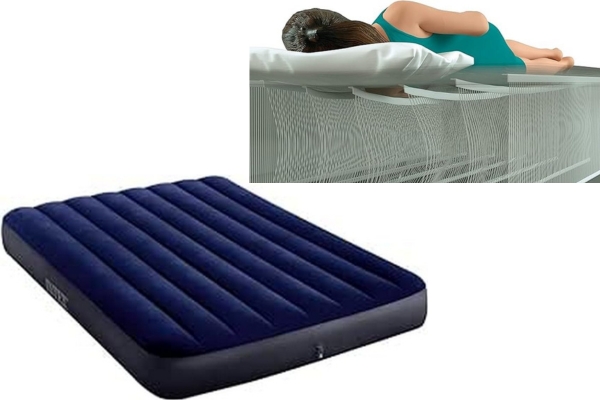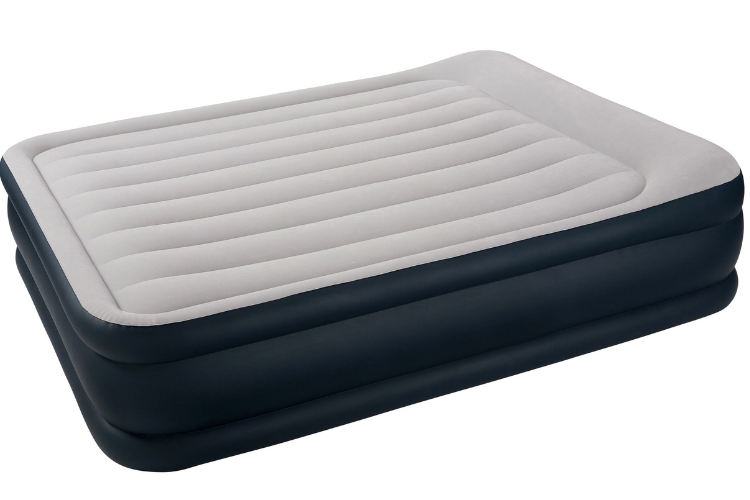Air mattresses have become increasingly popular for various reasons, ranging from temporary bedding solutions for guests to camping trips and even as a permanent sleeping arrangement.
However, one common question that arises among air mattress users is whether it’s safe or advisable to leave these inflatable beds inflated all the time.
In this blog post guide, we’ll explore the pros and cons of leaving an air mattress inflated, provide expert tips, and offer insights to help you make an informed decision.
Understanding Air Mattress Construction
Before delving into the specifics of leaving an air mattress inflated, it’s essential to understand the basic construction and components of these inflatable beds. Air mattresses typically consist of the following parts:
- Outer Shell: The outer shell is typically made of durable, puncture-resistant materials like polyvinyl chloride (PVC) or polyester. This layer provides structural integrity and protects the inner air chambers.
- Air Chambers: The core of an air mattress consists of one or more air chambers, which are inflated to create the mattress’s firmness and shape.
- Valve System: Air mattresses are equipped with a valve system, often a built-in pump or an external pump, that allows for inflation and deflation.
- Support Structures: Some air mattresses incorporate additional support structures, such as internal coils or beams, to enhance stability and distribute weight evenly.

Factors to Consider: Pros and Cons
Leaving an air mattress inflated all the time can have both advantages and disadvantages. Let’s explore these factors in detail:
Pros of Leaving an Air Mattress Inflated
- Convenience: Keeping an air mattress inflated eliminates the need for repeated inflation and deflation, saving time and effort.
- Consistent Firmness: Leaving an air mattress inflated can help maintain its desired firmness level, providing a consistent sleeping experience.
- Reduced Wear and Tear: Repeatedly inflating and deflating an air mattress can cause strain on the materials and valves, potentially leading to premature wear and tear. Leaving it inflated can prolong its lifespan.
- Immediate Availability: An inflated air mattress is ready for use at any time, making it convenient for unexpected guests or spontaneous sleepovers.
Cons of Leaving an Air Mattress Inflated
- Air Loss: Even high-quality air mattresses can experience gradual air loss over time, requiring periodic re-inflation to maintain the desired firmness.
- Material Degradation: Prolonged exposure to air pressure and environmental factors like heat, humidity, and sunlight can cause the materials to degrade, potentially leading to leaks or structural damage.
- Space Constraints: Leaving an air mattress inflated can take up valuable floor space, making it challenging to use the area for other purposes.
- Potential Safety Concerns: In rare cases, leaving an air mattress inflated for extended periods could increase the risk of punctures or leaks, which might pose a safety hazard, especially for children or pets.

Expert Tips for Leaving an Air Mattress Inflated
If you decide to leave your air mattress inflated, consider the following expert tips to ensure safety, longevity, and optimal performance:
- Use a High-Quality Air Mattress: Invest in a well-constructed, durable air mattress from a reputable brand. Higher-quality mattresses are typically better equipped to handle prolonged inflation.
- Inspect Regularly: Conduct periodic inspections for signs of air loss, punctures, or material degradation. Address any issues promptly to prevent further damage.
- Rotate and Flip: Regularly rotate and flip the air mattress to distribute wear and tear evenly across the surface.
- Maintain Optimal Inflation: Monitor the firmness level and adjust the inflation as needed to maintain the desired level of support and comfort.
- Provide Ventilation: Ensure proper ventilation around the air mattress to prevent moisture buildup, which can lead to mold or mildew growth.
- Avoid Direct Sunlight and Heat Sources: Prolonged exposure to direct sunlight or heat sources can accelerate material degradation. Position the air mattress in a cool, shaded area when possible.
- Consider Periodic Deflation: If leaving the air mattress inflated for extended periods, consider deflating and re-inflating it periodically (e.g., every few months) to allow the materials to rest and prevent permanent deformation.
Air Mattress Usage and Lifespan: A Comprehensive Table
To help you make an informed decision, consider the following table, which outlines recommended usage scenarios and expected lifespans for air mattresses based on various usage patterns:
| Usage Scenario | Recommended Inflation Duration | Expected Lifespan |
|---|---|---|
| Temporary Guest Bedding | Inflate as needed, deflate after use | 1-3 years |
| Camping/Outdoor Use | Inflate for the duration of the trip, deflate after use | 1-2 years |
| Occasional Use (Sleepovers, etc.) | Inflate as needed, deflate after use | 2-4 years |
| Semi-Permanent Use (Spare Room, etc.) | Inflate and leave inflated for extended periods, with periodic deflation | 2-3 years |
| Permanent Sleeping Arrangement | Inflate and leave inflated, with regular maintenance and periodic replacement | 1-2 years |
Please note that the lifespans provided in the table are approximate and can vary depending on the quality of the air mattress, usage patterns, and environmental factors.
Alternative Solutions and Considerations
While leaving an air mattress inflated can be convenient in certain situations, it’s essential to weigh the pros and cons carefully. If you have concerns about the potential drawbacks of prolonged inflation, consider exploring alternative solutions:
- Invest in a High-Quality Traditional Mattress: For a permanent sleeping arrangement, a high-quality traditional mattress may be a more practical and long-lasting solution.
- Use an Air Mattress with Built-In Pumps: Some air mattresses feature built-in pumps that automatically maintain the desired firmness level, reducing the need for manual inflation and deflation.
- Explore Inflatable Bed Frames or Bases: Inflatable bed frames or bases can provide a stable foundation for traditional mattresses while offering the convenience of inflation and deflation.
- Consider Space-Saving Solutions: If space is a concern, explore space-saving options like folding or rollaway beds, which can be easily stored when not in use.
Remember, the decision to leave an air mattress inflated or not depends on your specific needs, usage patterns, and personal preferences. By carefully weighing the factors and considering expert advice, you can make an informed choice that ensures your comfort, safety, and peace of mind.

